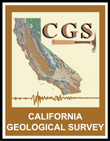
|
California Division of Mines
Special Report 68 Igneous and Metamorphic Rocks of the Western Portion of Joshua Tree National Monument, Riverside and San Bernardino Counties, California |
SUMMARY OF STRUCTURAL FEATURES
Faults. The area is cut by three major faults, all of which trend east-west and are associated with definite scarps. The absence of faults without associated scarps may simply indicate the difficulty of recognizing faults in crystalline rocks without the aid of related topographic features.
The Pinto Mountain fault, first named by Hill (1928), is apparently the largest fault in the region. It crops out about a quarter of a mile north of the Pinto and part of the Little San Bernardino Mountains and this movement may have been responsible for part of the uplift of these mountains. The Pinto Mountain fault has recently been discussed by Allen (1957).
The Eagle Mountain fault, also named by Hill (1928), marks the southern edge of the Hexie Mountains in Pleasant Valley and cuts through the Little San Bernardino Mountains along two sharp canyons. The movement on the fault is unknown.
The other major fault in the area is a hypothetical one along the south face of Queen Mountain. The sharpness of this face and the difference in rock types north and south of the mountain front indicate the possible presence of a fault. The evidence, however, is not conclusive.
Joints. The only rocks in the area in which jointing is well developed are the White Tank quartz monzonite and portions of the Palms quartz monzonite overlying masses of the White Tank. In some places, especially near the axes of minor folds, the gneiss is broken into small, many-sided blocks which certainly represent a type of jointing; but major joint patterns are restricted to the large plutonic bodies. Joints in the White Tank quartz monzonite include a horizontal sheeting and two roughly vertical sets of joints intersecting at nearly right angles. The orientation of these vertical joints varies from place to place, but commonly one joint direction is parallel and one normal to the contact with surrounding gneissic wall rocks. The trend of the vertical joints extends unchanged into thin layers of Palms quartz monzonite overlying the White Tank quartz monzonite, but the joint blocks are generally slightly smaller in the Palms quartz monzonite.
Foliation. The only foliated rocks in the area are the Pinto gneiss and Unit B of the Palms quartz monzonite. In general, foliation trends north or northwest where it is not warped into other orientations in the vicinity of the White Tank quartz monzonite. In some places in the western part of the Little San Bernardino Mountains, the foliation in the gneiss strikes nearly east-west, but such places seem to represent merely local flexures in the general northwesterly strike. Foliation in the gneiss is commonly vertical except where the strike differs markedly from the northwest. Foliation in Unit B of the Palms quartz monzonite generally has the same orientation as that in the neighboring gneiss.
| <<< Previous | <<< Contents >>> | Next >>> |
ca/cdm-sr-68/sec3.htm
Last Updated: 18-Jan-2007